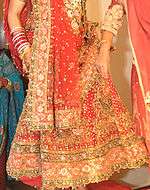Lehenga

Lehenga or lehnga or Ghagra in Hindi, Urdu, Punjabi, Gujarati and Kashmiri or Pavadai in Tamil or Langa in Telugu and Kannada [1] is a form of Indian subcontinent skirt which is long, embroidered and pleated. It is worn as the bottom portion of a Gagra choli or Langa Voni. It is secured at the waist and leaves the lower back and midriff bare.[2] In India and Pakistan various types of traditional embroidery work are done on lehenga, with Gota patti embroidery being one of popular types for the festivals and weddings.
History
The ancient version of skirt or Ghagri evolved from Bhairnivasani, which in turn evolved from the Antariya when stitched on one side became tabular and was worn gathered together at the waist, and held by a girdle. This was one of the earliest forms of a stitched skirt. It was worn using drawstring or nada.
Variations
The ghagri was a narrow skirt six feet long the same length as original antariya. This style can still be seen worn by Jain nuns in India.
In Andhra Pradesh and Karnataka it is known as Langa and part of the dress Langa Voni.
References
| Wikimedia Commons has media related to Lehenga. |
| ||||||||||||||||||